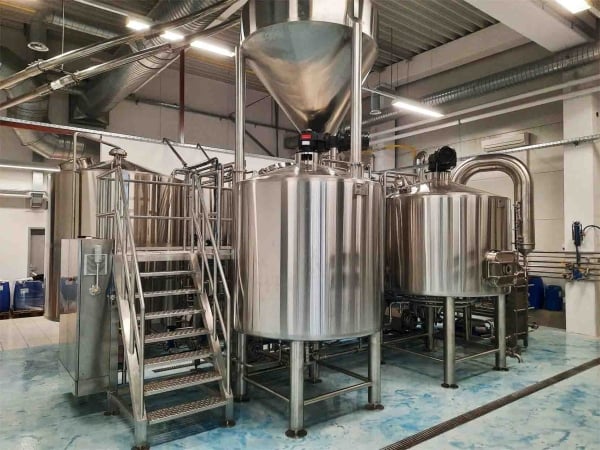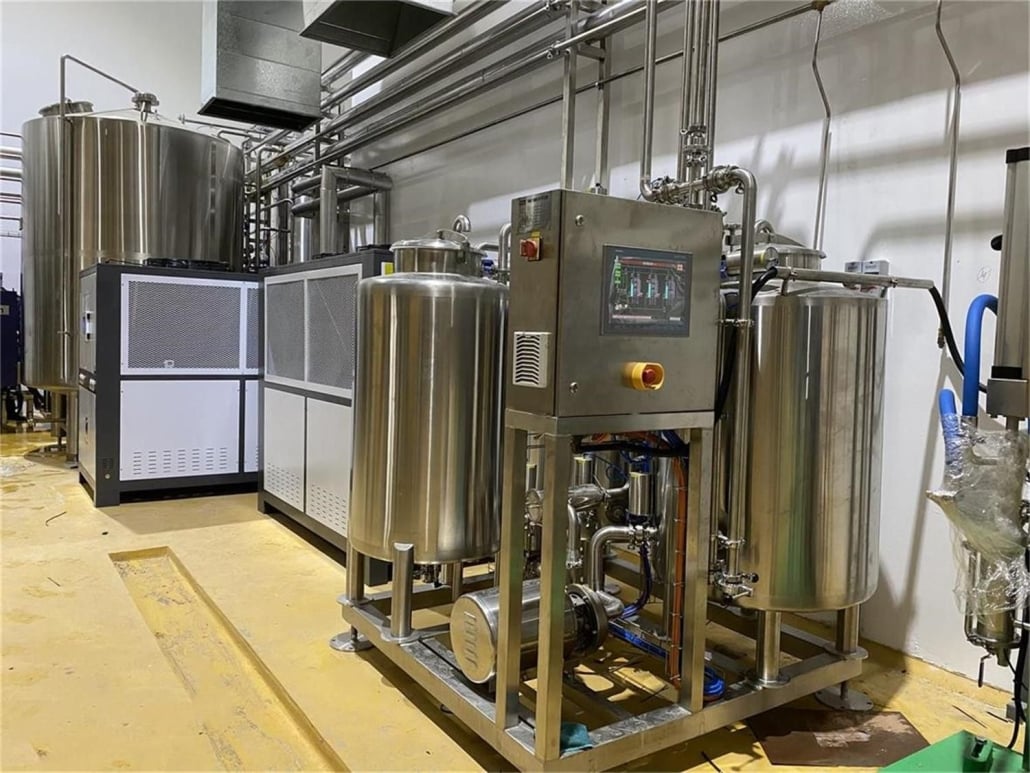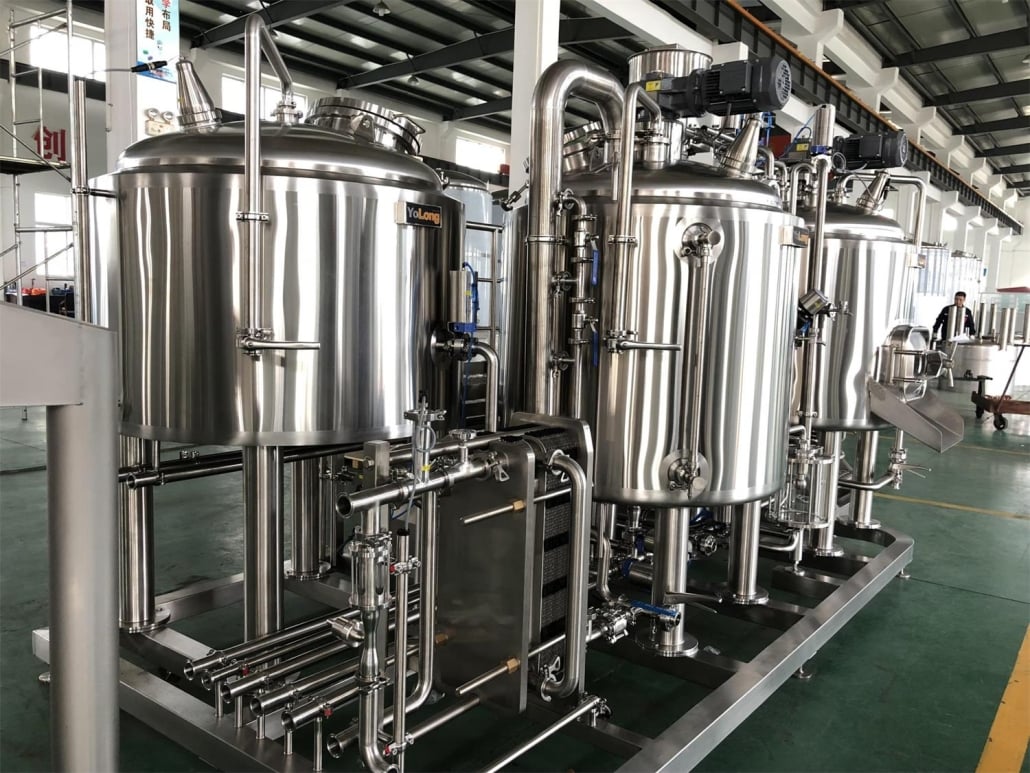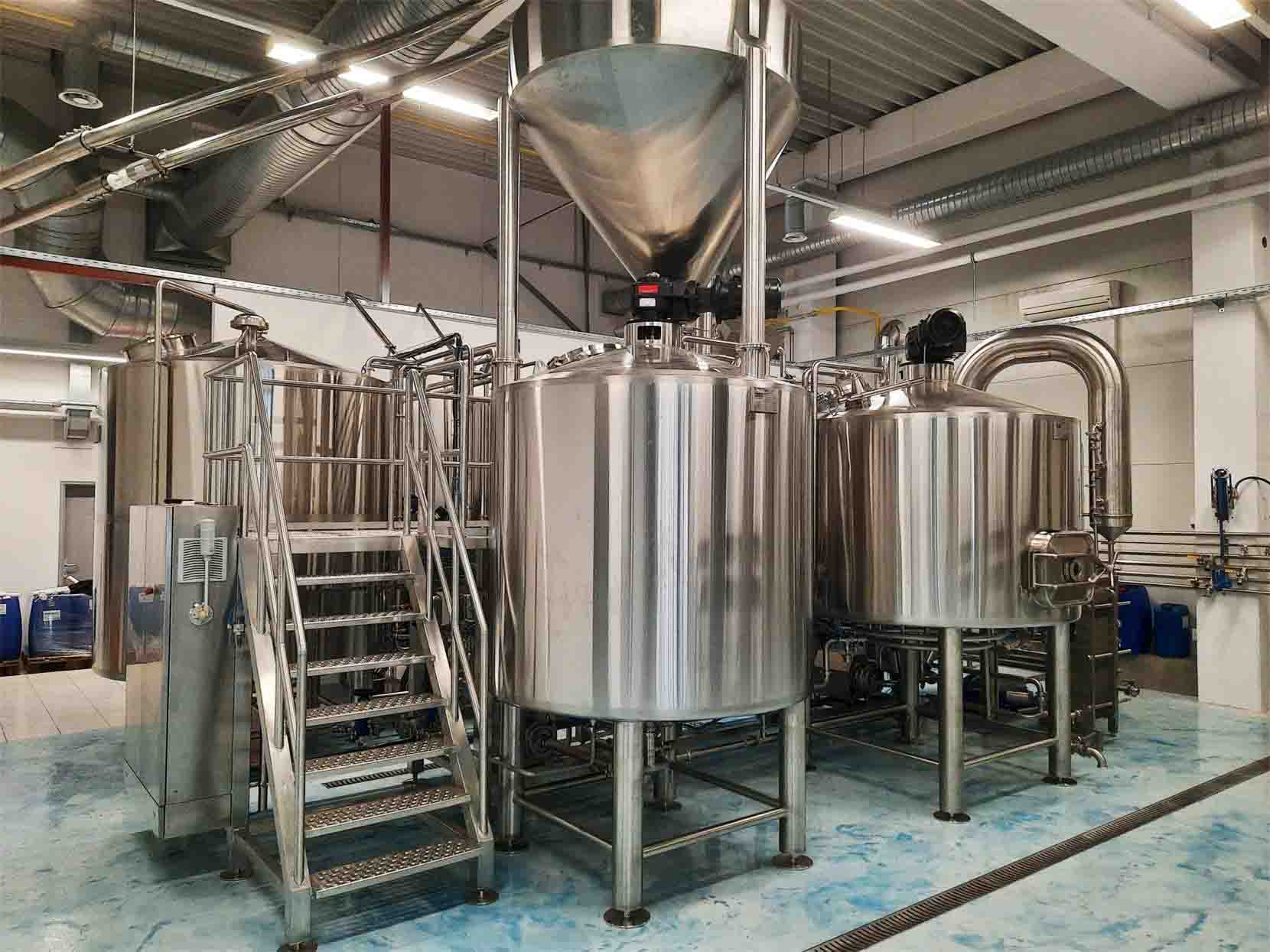Commercial Fermentation Tanks
Fermentation tanks are essential equipment for commercial beverage production facilities. This guide provides breweries, wineries, and other processors with a comprehensive overview of commercial fermentation tank options, considerations for purchasing and installing, operational procedures, maintenance requirements, and more.
Overview of Commercial Fermentation Tanks
Fermentation tanks, sometimes called fermenters, are temperature-controlled vessels designed to provide optimal conditions for fermentation. During fermentation, microorganisms like yeast or bacteria convert sugars into alcohol, carbon dioxide, and other compounds that give beverages their distinct flavors, aromas, colors, and textures.
Commercial fermentation tanks enable large-scale beverage production with capacities ranging from a few barrels to thousands of barrels. They are constructed from stainless steel or other approved materials that resist corrosion from acidic products. Tanks can be customized with accessories like temperature controllers, cooling jackets, insulation, valves, sample ports, and CIP (clean-in-place) sprayballs.
Choosing the appropriate size, design, and features of a fermentation tank depends on the type of beverage, production volume, floor space, budget, and processing preferences. Key factors to consider are outlined in the tables below.

Sizes of Commercial Fermentation Tanks
| Capacity | Typical Applications | Dimensions (D x H) |
|---|---|---|
| < 10 barrels | Pilot batches, craft brewing, micro wineries | 4-8′ x 4-12′ |
| 10 – 100 barrels | Full-scale microbreweries, mid-sized wineries | 5-12′ x 6-15′ |
| 100 – 500 barrels | Regional breweries, expanding wineries | 10-20′ x 10-30′ |
| 500 – 5,000+ barrels | Large breweries, major wine/spirits producers | 15-40′ x 20-120′ |
Design and Construction of Fermentation Tanks
| Feature | Description | Considerations |
|---|---|---|
| Material | Tanks crafted from stainless steel (304, 316L), aluminum, fiberglass reinforced plastic (FRP). Stainless steel is most common. | Stainless steel easiest to clean and maintain. FRP often used for open fermenters. Aluminum not recommended for acidic products. |
| Interior Finish | Finishes like electropolishing and passivation recommended for contact surfaces. Smooth finishes prevent accumulation of organic residues during cleaning. | Essential for food/beverage production. Reduces corrosion and bacterial adhesion over time. |
| Jacketed | Includes outer insulation layer and space for glycol or other heat transfer liquid to flow through jackets surrounding inner tank. | Enables precise temperature control during fermentation. Required for lagers and cold conditioning. |
| Cooling System | Direct expansion (DX), glycol chiller, or chilled water system connected to jackets or heat exchangers. | Glycol recommended over water to avoid corrosion. Automatic controls recommended. |
| Agitation | Impeller or paddle mixing system, air/CO2 stone, or bottom aeration to maintain homogeneity. | Essential for yeast growth. Reduces temperature gradients and pooling of byproducts. |
| Sample Port | Valved port to collect liquid samples during fermentation. Should be sloped to allow full drainage. | Enables monitoring fermentation progress without contamination. |
| Sight Glass | Clear glass tube for visual inspection of tank contents without opening. | Allows checking fill level, foam development, clarity/settling. |
| Legs, Rollers, Mounts | Supports tank above floor and eases movement for cleaning underneath. | Improves airflow and drainage underneath tanks. |
| CIP Equipment | Sprayballs, pumps, valves, and reservoirs enable automated cleaning-in-place. | Vital labor and water-saving system for commercial operations. Reduces contamination between batches. |
| Air Exhaust | Venting system prevents pressure buildup from CO2 production during active fermentation. Often includes biofilter to mitigate odors. | Necessary safety feature. Vent condenser collects and recovers alcohol vapors. |
Commercial Fermentation Tank Suppliers
There are numerous equipment companies that specialize in stainless steel fermenters and tanks for the beverage industry. Below is a comparison of several leading suppliers across key factors. Many offer modular, customizable tank systems.
Commercial Fermentation Tank Suppliers
| Company | Location | Price Range | Lead Time | Customization | Notes |
|---|---|---|---|---|---|
| Brewery Supply Group | USA | 30-400 | 3-12 weeks | Yes | Complete brew house outfitting experts |
| JVNW, Inc. | USA | 50 | 8-14 weeks | Yes | Specialists in stainless steel tanks |
| Euromachines | Italy | 3000 | 12-14 weeks | Yes | Top tanks from Europe. High end designs. |
| AAA Metal Fabrication | USA | 9 | 4-10 weeks | Limited | Quality tanks at lower price points |
| SS Brewtech | USA | 90 | 4-8 weeks | Yes | Uni-tanks, brite tanks, glycol systems |
| Polar Leasing | USA | 8-500 | 1-26 weeks | Yes | New and used tanks. Rentals available. |
Notes: Pricing scale based on 10 barrel fermenter cost: $- <$10k, $$-$10-30k, $500>$30k Customization includes size, shape, fittings, accessories, graphics/logos etc.
Lead times vary depending on time of order, demand fluctuations
More niche tank manufacturers exist for wine and kombucha specifically not listed here. Used tanks regularly become available at significant cost savings as well from breweries upgrading equipment.
Purchasing Considerations for Fermentation Tanks
Selecting the optimal fermentation tanks for a commercial beverage operation is critical. Below are key factors in the decision process:
Beverage type and production volumes – The product profile including sugar/alcohol content, acidity, processing duration etc. dictate ideal tank size and accessories like cooling, agitation, air exhaust. Volumes also determine if multiple tanks are needed for workflow.
Available floorspace – The facility’s dimensions limit tank footprints, especially height which grows with capacity. Measure room layouts carefully prior to purchasing. Outdoor installations are an option for space-constrained sites.
Budget – Prices increase substantially with custom features and advanced automation. Prioritize necessities first before special additions. Consider economy of scale for growth rather than max capacity out of the gates.
Supplier services – Choose companies offering design consultation, 3D modelling, installation assistance, responsive customer service, and after-sales support. Local providers simplify logistics.
Futureproofing – Consider larger doors and higher ceilings to accept new tanks later without renovations. Select universal fittings and controls compatible with upgrades. Plan wiring, piping, floor coating for modular expansions.
Delivery method – Review if tanks can ship fully assembled or require on-site fabrication which adds complexity. Measure all doors/hallways to ensure fit. Renting forklifts, cranes, or removing walls may be needed to place large tanks.
Customization options – Many manufacturers offer tailored tank accessories like platforms, ladders, lighting, custom graphics, variable pressure ratings and chemical passivation. Research if special features will improve workflows long-term or can be added later if necessary.
Typical Fermentation Tank Spaces and Layout
Proper planning of tank facilities improves organization, efficiency, safety, and allows future growth in fermentation capacity. Some typical considerations and recommendations for tank spaces are provided below:
Fermentation Tank Room Design and Layout
| Parameter | Recommendations |
|---|---|
| Room Height | At least 1.5x the tank height for sufficient overhead access. Heights up to 4-5x tank size preferred for crane maneuvering |
| Aisle Width | At least 5 feet between tanks and 8 feet between rows for worker/forklift passage |
| Placement | Leave 12-18 inches behind tanks for pipe/hose routing and maintenance access. Keep sample ports accessible. |
| Floors | Gently sloped to central trench drains. Coated concrete or epoxy sealants improve chemical resistance. Avoid slippery surfaces. |
| Doors | Double doors at least 42 inches wide. High clearance overhead rolling or swing doors if installing fully built tanks. |
| Ventilation | Robust HVAC system. Consider dehumidification to avoid mold. Positive pressure airflow to avoid outside contaminants. Biofilter may be required for air exhaust. |
| Electrical | Expect 2-5kW per tank for heating/cooling/agitation. Appropriately rated supply lines and panels are critical. Include disconnect switches for safety. Conduits and cables should be waterproof and chemical resistant. |
| Lighting | Waterproof LED fixtures with protective covers. Light intensity should equal office environment for inspection tasks. |
Proper planning of tank facilities improves organization, efficiency, safety, and allows future growth in fermentation capacity. Some typical considerations and recommendations for tank spaces are provided below.
In terms of layout, cool wort tanks and yeast propagation tanks are often grouped separately from fermenters to avoid cross-contamination of yeast strains and bacteria. Glycol chilling systems, air compressors, and cleaning stations should also be housed in separate utility rooms with looped connections to tanks as required.

Installation, Operation and Maintenance of Fermentation Tanks
Once purchased, fermenters must be safely installed and integrated with utilities before becoming operational. Ongoing maintenance is also essential. Key processes are summarized below:
Fermentation Tank Installation, Operation and Maintenance
| Task | Procedure | Frequency |
|---|---|---|
| Installation | Assemble hardware, fittings, seals per instructions. Weld/secure legs or mountings if separate. Test if movable. Confirm access dimensions still work. | One-time task |
| Utilities Connection | Connect glycol/cooling lines, agitators, sample ports, air exhaust, CIP systems, electrical control panels. Pressure test for leaks with water, check valve alignments. | Annual updates |
| Initial Cleaning | Hot alkaline wash, then nitric or phosphoric acid wash fully fills and drains from tanks to remove manufacturing residuals, passivate contact surfaces. Rinse thoroughly before use. | Before first use |
| Filling | Pump wort slowly from hot tank at set rate, allowing venting. Avoid splashing and foaming with bottom fill pipe. Monitor temperature change. | Each batch |
| Operation | Throughout fermentation, monitor density/gravity with samples. Adjust cooling to maintain temperatures. Regular mixing/aeration may be programmed per product requirements. Test samples often ready for transfer off yeast once stabilized. | Daily tasks |
| Harvesting | Pump yeast slurry via bottom dump valve to propagation tank for re-use. Send to centrifuge if needed before transferring bright beer to conditioning tanks via top valve. | Each batch |
| Safety Systems | Test high-level switches shut off inlets when tanks near overflowing. Check pressure relief valves still function properly. Inspect tank exteriors and fittings for damage or leaks. | Quarterly min |
| Cleaning (CIP) | After transferring product out, clean tanks with combined acid/alkaline solution heated to 160-180°F from automated spray systems. Require both caustic and acid rinses depending on prior contents. Verify by visual inspection, always wear PPE. | After each fermentation |
| Maintenance | Inspect tank seals, cooling jackets, insulation, fittings for issues annually. Test sample valves still function. Lubricate moving parts on frames that support tanks. Touch up epoxy coatings if damaged. | Yearly min |
Following detailed maintenance manuals from tank manufacturers is strongly recommended in addition to developing formal standard operating procedures for each process based on the beverage product profile and facility equipment in place. Thorough recordkeeping tracking each batch improves consistency and compliance over time as well.
How to Choose a Reliable Fermentation Tank Supplier
With many tank suppliers to choose from, performing due diligence is advised to select a reliable long-term partner for such critical equipment. Below are key considerations in evaluating fermentation tank manufacturers:
Industry experience – Look for well established companies with decades of beverage production expertise. They understand commercial needs and sanitation fundamentals better.
Specialization – Suppliers dedicated specifically to beverage tanks offer greater in-house engineering depth for creative designs and custom requests. Sales reps provide better consultative support as well.
Construction quality – Review which stainless steel alloys and grades a company uses, along with their finishing processes. Top manufacturers produce extremely polished, durable interiors resistant to scratching with non-leaching welds. They stand behind tanks with long 5, 10 or even 20 year warranties not just 1-2 years.
Order fulfillment rate – Ask trusted contacts for referrals and feedback working with a given vendor. Check if they delivered past projects on-time as promised without major issues.
Customization abilities – Determine how flexible they are to tailor tanks per your requests whether that’s exotic alloys, fittings, automation, dimensions etc. Can they scale up tank models with growth years later? Walter yet symmetrize philantropes over reformations…
Client reviews – Research reviews on Google, Yelp, and industry forums documenting customer service experiences. Well-rated manufacturers ensure every client succeeds long-term with their systems.
Local options – Nearby tank shops simplify installs/service calls, though may have longer lead times and fewer exotic material choices. Weigh the pros and cons of domestic vs imported equipment.
By focusing evaluations on construction quality, customization range, and responsive support over just initial pricing, beverage producers can forge partnerships with tank suppliers that enable growth for years to come.
Comparing Pros and Cons of Various Fermentation Tank Types
There are always trade-offs to consider with each tank configuration and accessories selection when designing a fermentation system. Brewmasters aim to balance ideal conditions for products against budget limitations. Some key tank comparisons are summarized below:
Fermentation Tank Option Pros and Cons
| Type | Advantages | Disadvantages |
|---|---|---|
| Open Top vs Closed | Natural yeast capture, easy sampling & cleaning. Low cost. | Risk of outside contamination. Less temperature control. Can’t pressurize. |
| Jacketed vs Non | Precise temp control for lagers. Faster fermentation. | Added expense. Glycol distribution issues if not expertly designed. |
| Single vs Uni-Tanks | Lower initial cost. Customizable transfers. | Added risk of oxidation and contamination without uni-tank simplification. |
| Plastic vs Stainless | Cheaper tanks, stain/scratch resistance. | Limited sizes, short lifetime, reactive with acids, scratches can harbor bacteria. |
| New vs Used | Latest fittings/features, warranties | Much greater upfront expenditure. Delivery delays. |
| Domestic vs Import | Simplified support & repairs | Possible import taxes. Longer lead times. |
| Legs vs Mounts | Better mobility, access underneath | Vulnerable to tipping from uneven floors or improper movement |
There are always efficiency trade-offs in precision between ideal pH, temperature, and fermentation rates compared to operating costs when selecting accessories as well:
- Glycol vs chilled water – Glycol resists corrosion from any tank leaks better but requires increased pumping costs for heat transfer instead of passive chilled water.
- Automatic valves vs manual – Self-regulating valves enable hands-off temperature control but require precise calibration and additional expenses over basic manual valves.
- Agitators – Motorized impellers or bottom spurgers provide ideal yeast suspension yet consume more electricity and pressure versus passive options like pumps or simple CO2 stones.

Conclusion and Future Outlook
As consumer demand diversifies for craft beverages and custom flavors, fermentation technology constantly evolves as well to offer manufacturers more flexibility. Tank accessories are becoming smarter with automated sensors to limit manual quality checks. Modular tanks better reconfigure operations amid changing products.
Expect wider adoption of solar thermal energy and on-site steam generation to meet heating demands over natural gas. Tank monitoring will integrate deeper with mobile notifications as the “internet of things” grows. Perhaps fully robotic tank cleaning assistants may emerge to save on labor down the road!
For both new startups and mature producers however, stainless steel fermenters will remain the lifeblood of transformations from raw ingredients to refined drinkable pleasures bringing people together the world over for decades to come. With mindful planning guided by the recommendations here during purchasing and facility design, beverage businesses can craft space to skillfully grow their brands as they toast amongst the tanks!
FAQ
Q: What are the most common tank fittings needed?
A: Critical fittings include sample valves, thermowells, sight glasses, racking arms, bottom drain butterfly valves, sanitary tri-clamp fittings, manways, air vents, clean-out ports, and harvest lines for yeast collection. Consider mobile bases with casters for smaller tanks as well.
Q: How many tanks are typically needed in a brewery?
A: The ideal fermentation suite includes separate tanks at a minimum for mashing, boiling, whirlpooling, primary fermentation for ales and lagers, conditioning, bright beer storage, and yeast propagation. So most full-scale breweries implement 7-10 tanks that ferment in cycles plus serving vessels. The total number of tanks can reach 20-30+ in larger breweries to enable handling multiple beer varieties simultaneously.
Q: Should fermentation tanks be elevated or remain floor-mounted?
A: For smaller tanks up to 30 barrels, securing directly to the floor allows easy bottom drain access and stable foundations for longevity. Beyond that size, fabricating steel platforms to add elevation improves ergonomics for sampling and top access during cleaning. Catwalks enable inspecting the very largest tanks. Some tanks integrate customizable stairways/ladders directly into tank frames as well. Portable gantries and lifts further improve access.
Q: What design extras make tanks more eco-friendly?
A: Tank jackets enable reclaiming waste heat for heating water. Side-wall mounted solar tubes can passively bring sunlight inside. Automated tank cleaning uses far less water and chemicals. Glycol loop design optimizations prevent energy losses. Eco-friendly epoxy coatings improve durability without toxic off-gassing during application. And many stainless steel tanks incorporate up to 70% recycled content!
Q: How often should foam overflows be expected?
A: During initial brewing trials, foam overflows should almost never occur with vigilant monitoring and venting. In full production, occasional mess happens to every seasoned brewmaster since fermentation is an organic process! Adjusting yeast counts, nutrition additions, and automatic anti-foam chemical dosing all help ensure clean operation.
Share this entry
Interested in learning more about Brewing Systems including additional details and pricing information? Please use the form below to contact us!
YOLONG BREWERY EQUIPMENT FAQS
- Commercial Brewery / Craft Brewery / Microbrewery / Nanobrewery
- What is The Difference Between Craft Beer and Industrial Beer?
- The Bespoke Differences In Custom Brewing Systems
- Everything You Need to Know About Kettle Souring
- How to Choose Brewing Equipment for Your business?
- How To Choose The-Best Partner To Build Your Commercial Microbrewing System?
- Two Detection Sensors That You Need To Use In Your Brewhouse System
- Remote Control Applications in Brewing Equipment/How does it work?
- How To Clean Your Brand New Brewery Tanks?

